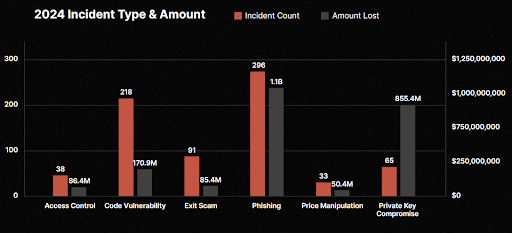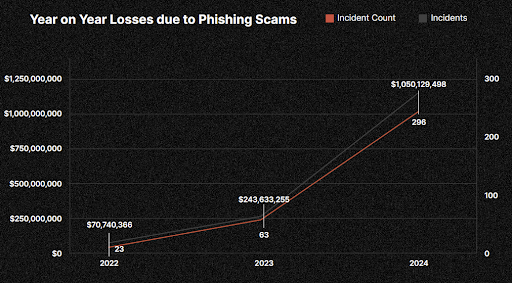Phishing Scammers Dominated Crypto Crime in 2024: Here's How to Avoid Them

Phishing in the cryptoasset sector has been a growing trend in recent years, resulting in more than $1 billion in losses in 2024. Read on to learn how you can protect yourself.
While the total losses in the cryptoasset industry due to crime surpassed $2.3 billion last year—a 32% increase from 2023—nearly half of this amount was attributed to phishing attacks, according to data from crypto security specialist CertiK. Moreover, these figures come from just 296 registered phishing cases, with three incidents alone netting criminals over $100 million. This suggests phishing attacks often lead to significantly higher losses per incident compared to other types of crypto crimes.

Compared to 2023, losses from phishing increased more than fourfold.

The researchers also noted that if phishing data is excluded from the total losses, "it seems that ecosystem security is improving."
"Phishing’s popularity among attackers stems from its simplicity and effectiveness: phishing preys on human vulnerabilities rather than solely targeting technological defenses. By crafting deceptive emails, fake websites, or fraudulent messages, attackers trick users into divulging sensitive information like passwords, private keys, or wallet addresses," CertiK explained.
They emphasized that the irreversible nature of cryptoasset transactions makes phishing particularly devastating. However, while crypto hackers often rush to launder stolen funds, "it appears that the majority of funds stolen due to phishing attacks have not yet been laundered."
According to the security researchers, here’s how you can protect yourself from phishing attacks:
- Be cautious with unexpected communication: Exercise caution with unexpected emails, messages, or calls, especially those requesting personal information or urging immediate action. Verify the sender’s authenticity before responding.
- Double-check email addresses and URLs: Carefully examine email addresses and website URLs for misspellings or unusual characteristics that may indicate fraudulent sources. Hover over links to preview their destinations without clicking to confirm they lead to legitimate sites.
- Enable Two-Factor Authentication (2FA): Adding 2FA provides an extra layer of security to your accounts.
- Update software regularly: Keeping your operating systems, browsers, and applications updated reduces opportunities for cybercriminals to exploit vulnerabilities.
- Stay informed: Educate yourself about the latest phishing tactics and scams to recognize and avoid them.
- Double-check wallet addresses: Always verify wallet addresses before sending cryptoassets, as criminals can replace legitimate addresses with fraudulent ones.
- Use hardware wallets: Storing your cryptoassets offline in a hardware wallet makes it harder for scammers to access your funds.
- Use a secure internet connection: Avoid public Wi-Fi, which can expose you to phishing attacks and man-in-the-middle threats. Opt for a private and secure connection instead - VPN (Virtual Private Network)
Stay vigilant!